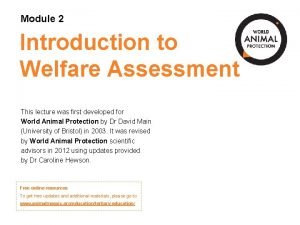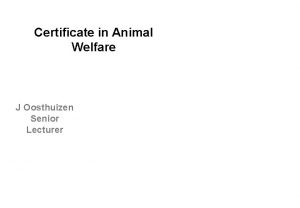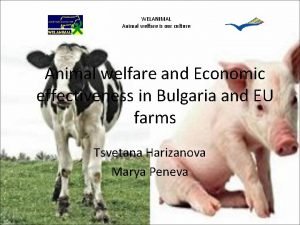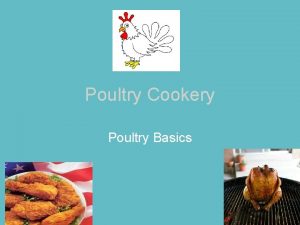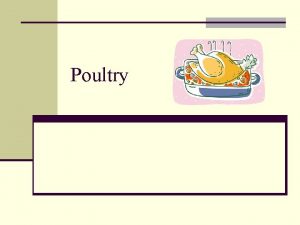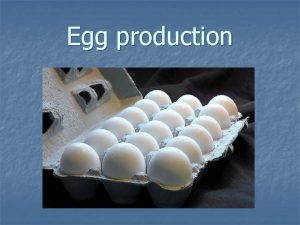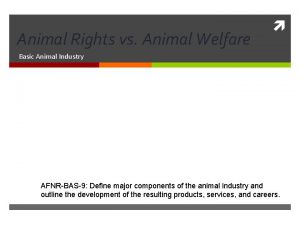Organic Poultry Industry Animal Welfare Survey Organic Egg









- Slides: 9

Organic Poultry Industry Animal Welfare Survey Organic Egg Farmers of America 2014

Methodology & Acknowledgments • The Organic Egg Farmers of America (OEFA) conducted a survey of organic poultry operations asking a number of questions regarding the animal welfare standards passed by the NOSB on December, 2011. • The Organic Trade Association (OTA) provided OEFA technical support, 3 rd party confidential analysis of responses, and data compilation. This service was provided to OEFA free of charge as a benefit afforded to OEFA through its strategic alliance with OTA’s Farmer Advisory Council. • The survey in both electronic and hardcopy form was circulated to organic poultry producers throughout the United States via OTA membership lists, Accredited Certifying Agencies, and organic farming advocacy groups. The survey was conducted from July 16, 2014 through July 31, 2014. Distribution of the survey was limited to producers certified under USDA organic regulations. All responses remained confidential. • The survey received 157 responses (representing 8. 3 million organic laying hens and 12. 1 million organic broilers), which constitutes a response rate that provides a 95% confidence level with a confidence interval of 6. 65, based on the number of organic poultry producers reported in the 2011 NASS Organic Producer Survey (566). • Responses relating to other classes of poultry (turkeys, ducks, etc. ) and certain questions relating to broiler operations were not included in this summary to avoid disclosure of reported data from individual operations. If there were less than 4 respondents to a particular question, the data was not included in the survey. • OEFA formed in Fall of 2011. Our mission is to bring together various stakeholders dedicated to the production of eggs in compliance with the Organic Standards, and to create an environment of honesty and co-operation for the betterment of the industry as a whole.

Survey Objective • The National Organic Program (NOP) recently announced they are moving forward with rulemaking, in response to the animal welfare standards recommended by NOP on December 2, 2011. • The objective of the survey was to capture the current state of organic livestock production under NOP certification and the ramifications of adoption and implementation of the proposed animal welfare standards as passed by NOSB.

Operational Overview 2014 OEFA Survey Totals Number of Certified Organic Producers Number of Certified Organic Laying Hens Number of Certified Organic Broilers (annual production) 157 8, 331, 026 12, 286, 375 2011 NASS Organic Producer Survey Results Number of Certified Organic Producers Number of Certified Organic Laying Hens Number of Certified Organic Broilers (annual production) 566 6, 739, 949 19, 654, 307 Scale of Operations (Layers) 17; 11% 11; 7% 7; 5% 8; 5% >250, 000 Birds 100, 000 - 250, 000 birds 10, 000 - 100, 000 birds 1, 000 - 10, 000 birds 106; 71% <1, 000 birds

Operational Overview Does Your Operation Obtain Additional Private Animal Welfare Certifications for your Certified Organic Flocks? Number of Producers Number of Layers 1, 074, 826, 13% 37; 24% Yes No No 116 76% 6, 903, 200, 87% Number of Broilers 5, 875, 0% Yes No 12, 108, 700, 100%

Operational Overview 16 14 What is the depreciation rate (as reported on federal tax Schedule F forms) of your poultry houses (in years)? [Average of Reponses] 15 12, 75 What is the normal useful life of your poultry houses (in years)? [Average of Responses] 30 26, 7 25 12 20 10 18, 3 15, 9 15 8 6 10 4 5 2 0 0 Layer Houses Pullet Houses Broiler Houses

Outdoor Access and Spacing Requirements Do you currently have outdoor access that is exclusively enclosed space with a floor, walls, and roof (i. e. “poultry porch”)? OR Do you currently have outdoor access that allows poultry to contact the soil when seasonally appropriate? Number of Layers Number of Producers 7; 5% Outdoor Access is Poultry Porch 142; 95% Outdoor Access Allows Contact with Soil Number of Broilers Outdoor Access is Poultry Porch 11, 662, 775, 100% 1, 855, 085 24% Outdoor Access Allows Contact with Soil 5, 875, 666 76% [VALUE], 6. 5%[VALUE], 10% [VALUE], 2. 9% [VALUE], 4. 3% >250, 000 birds Scale of Operations Where Outdoor Access Allows Contact with Soil [VALUE], 76% Outdoor Access is Poultry Porch 100, 000 - 250, 000 birds 10, 000 - 100, 000 birds 1, 000 - 10, 000 birds <1, 000 birds

Outdoor Access and Spacing Requirements It is the intent of NOSB that outdoor areas provide birds with access to the soil when seasonally appropriate, sky overhead, and without a solid roof or walls. Can your operation(s) adapt to this proposed requirement? Number of Producers Number of Layers 5; 3% Yes No 144; 97% 2, 306, 500 30% Yes 5, 445, 601 70% No

Outdoor Access and Spacing Requirements The NOSB recommends at least 2 sq. ft. per bird (layers, pullets, and broilers) in outdoor pens and runs. Can your operation(s) meet this proposed requirement? Number of Producers Number of Layers 11; 7% 3, 146, 585 41% Yes No 139; 93% Number of Broilers 1, 324, 575, 11% Yes No 10, 510, 000 89% 4, 601, 116 59% Yes No
 Venn diagram of organelles in plant and animal cells
Venn diagram of organelles in plant and animal cells Animal cell plant cell venn diagram
Animal cell plant cell venn diagram Animal rights versus animal welfare
Animal rights versus animal welfare Chick embryo 72 hours diagram
Chick embryo 72 hours diagram The 5 freedoms animal welfare
The 5 freedoms animal welfare Higher certificate in animal welfare
Higher certificate in animal welfare Animal welfare bulgaria
Animal welfare bulgaria Tom and myrtle's apartment on map
Tom and myrtle's apartment on map East egg vs west egg
East egg vs west egg Where is east egg and west egg in the great gatsby
Where is east egg and west egg in the great gatsby




